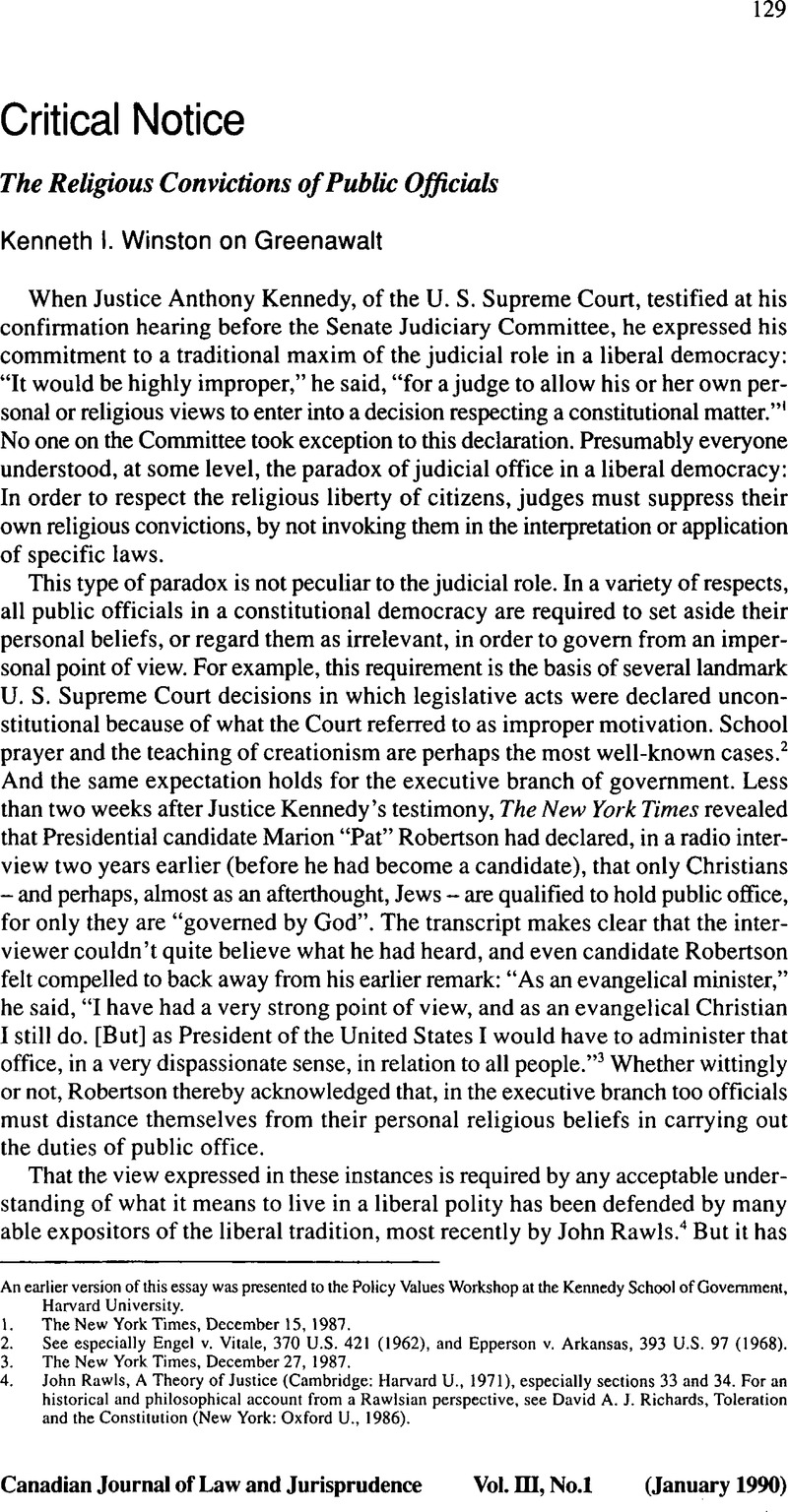No CrossRef data available.
Published online by Cambridge University Press: 09 June 2015

An earlier version of this essay was presented to the Policy Values Workshop at the Kennedy School of Government, Harvard University.
1. The New York Times, December 15, 1987.
2. See especially Engel v. Vitale, 370 U.S. 421 (1962), and Epperson v. Arkansas, 393 U.S. 97 (1968).
3. The New York Times, December 27, 1987.
4. Rawls, >John A Theory of Justice (Cambridge: Harvard U., 1971), especially sections 33 and 34.John+A+Theory+of+Justice+(Cambridge:+Harvard+U.,+1971),+especially+sections+33+and+34.>Google Scholar For an historical and philosophical account from a Rawlsian perspective, see David, >A.J. Richards, Toleration and the Constitution (New York: Oxford U., 1986).A.J.+Richards,+Toleration+and+the+Constitution+(New+York:+Oxford+U.,+1986).>Google Scholar
5. Greenawalt, Kent, Religious Convictions and Political Choice (New York: Oxford U., 1988).Google Scholar
6. Ibid., at 11.
7. MacCallum, >Gerald, “The Extent to Which Legislators Should Serve Their Consciences or Their Constituents” in Ethical Issues in Government, ed. Bowie, >Norman (Philadelphia: Temple U., 1981), 24.Google Scholar
8. Webster is one of the political heroes featured in Kennedy, John F., Profiles in Courage [memorial edition] (New York: Harper & Row, 1964), ch. III.Google Scholar
9. Greenawalt, supra note 5 at 31.
10. Ibid., at 30.
11. Ibid., at 45 n7.
12. Rawls, supra note 4 at 215.
13. Greenawalt, supra note 5 at 38.
14. Nagel, Thomas, “Moral Conflict and Political Legitimacy” (1987), 16 Philosophy and Public Affairs 228 and 232.Google Scholar
15. Greenawalt, supra note 5, e.g., at 156ff.
16. Rawls, supra note 4.
17. It may be worth noting on Rousseau’s behalf that the worries he had in mind were more salient in European history just prior to the time he was writing. Rawls himself observes elsewhere: “Before the successful and peaceful practice of toleration in societies with liberal political institutions there was no way of knowing Rawls adds: “[I]t is difficult, if not impossible, to believe in the damnation of those with whom we have long cooperated on fair terms with trust and confidence.” Rawls, “The Idea of an Overlapping Consensus” (1987), 7 Oxford Journal of Legal Studies 23.
18. I think Rawls underestimates his commitments when he says that “the justification of a conception of justice is a practical social task rather than an epistemological or metaphysical problem.” I am inclined to think that practical social tasks do not get done without epistemological commitments. Rawls, “Justice as Fairness: Political not Metaphysical” (1985), 14 Philosophy and Public Affairs 224 n2.Google Scholar
19. See Nagel, supra note 14 at 229–33.
20. Ibid., at 232.
21. In these paragraphs, I am following (and adapting) Nagel’s discussion in The View From Nowhere (New York: Oxford U., 1986), especially ch. VIII.
22. See Winston, Kenneth “Toward A Liberal Conception of Legislation,” in Liberal Democracy eds. Pennock, J.R. and Chapman, J. (New York:New York Univ. Press, 1983, esp. at 320–26.Google Scholar
23. Greenawalt, supra note 5 at 242 n10.
24. Mario Cuomo, “Religious Belief and Public Morality: A Catholic Governor’s Perspective.” The quotations in the text are from pp. 4, 5, and 6 of the text released by the Governor’s office. The speech is reprinted in The New York Review of Books, October 25, 1984, and in the Notre Dame Journal of Law, Ethics, and Public Policy, vol. I (1984)
25. Greenawalt, supra note 5 at 55.
26. Cuomo’s remarks also make clear that it is a mistake to confuse the adoption of an impersonal standpoint with being “cold and unfeeling”. Carol Gilligan makes this mistake in “Moral Orientation and Moral Development,” Women and MoralTheory, eds. Eva Feder Kittay and DianaMeyers, T.(Totowa: Rowman & Littlefield, 1987),at31.Google Scholar
27. Greenawalt, supra note 5 at 110–12.
28. Ibid., atl21ff.
29. Ibid., at 174–75.
30. Ibid., at 90.
31. Ibid., e.g., at 224.
32. Ibid., at 110.
33. Ibid.
34. Ibid., at 136.
35. Ibid., at 148.
36. Cuomo’s remarks also make clear that it is a mistake to confuse the adoption of an impersonal standpoint with being “cold and unfeeling”. Carol Gilligan makes this mistake in “Moral Orientation and Moral Development,” Women and Moral Theory, eds. Elster, J. and Slagstad, R. (Cambridge, Eng.: Cambridge Univ. Press, 1988).Google Scholar
37. Greenawalt, supra note 5, e.g., at 113.
38. Greenawalt, supra note 5, e.g., at 131.
39. Greenawalt, supra note 5 at 206.
40. Ibid.
41. Ibid.
42. Stephan Jay Gould demonstrates how potentially fatal ignorance of science can be to liberal freedoms in “Justice Scalia’s Misunderstanding” (October 1987) Natural History, 15–21.
43. Greenawalt, supra note 5 at 206.
44. Greenawalt, supra note 5, e.g., at 167.
45. Ibid., at 41.
46. Ibid., at 42.
47. Ibid., at 73.
48. Ibid.
49. Ren6 Descartes, “Rules for the Direction of the Mind” in The Philosophical Works of Descartes, eds. Haldane, E.S. and Ross, G.R.T. (New York: Dover, 1955),I, 3.Google Scholar
50. Greenawalt, supra note 5 at 209.
51. Greenawalt, supra note 5 at 155.
52. Stephen K. Bailey says: “[TJhe paradox is that man’sself–respect is in large part determined by this capacity to make himself and others believe that self is an inadequate referent for decisional morality. This capacity of man to transcend, to sublimate, and to transform narrowly vested compulsions is at the heart of all civilized morality.” “Ethics and the Public Service” [original 1965), reprinted in Public Administration,ed. Richard Stillman, (Boston: Houghton Mifflin, 1984),483.Google Scholar
53. Greenawalt, supra note 5 at 176.
54. Greenawalt, supra note 5 at 178.
55. The New York Times, January 11,1989.
56. Greenawalt, supra note 5 at 155.